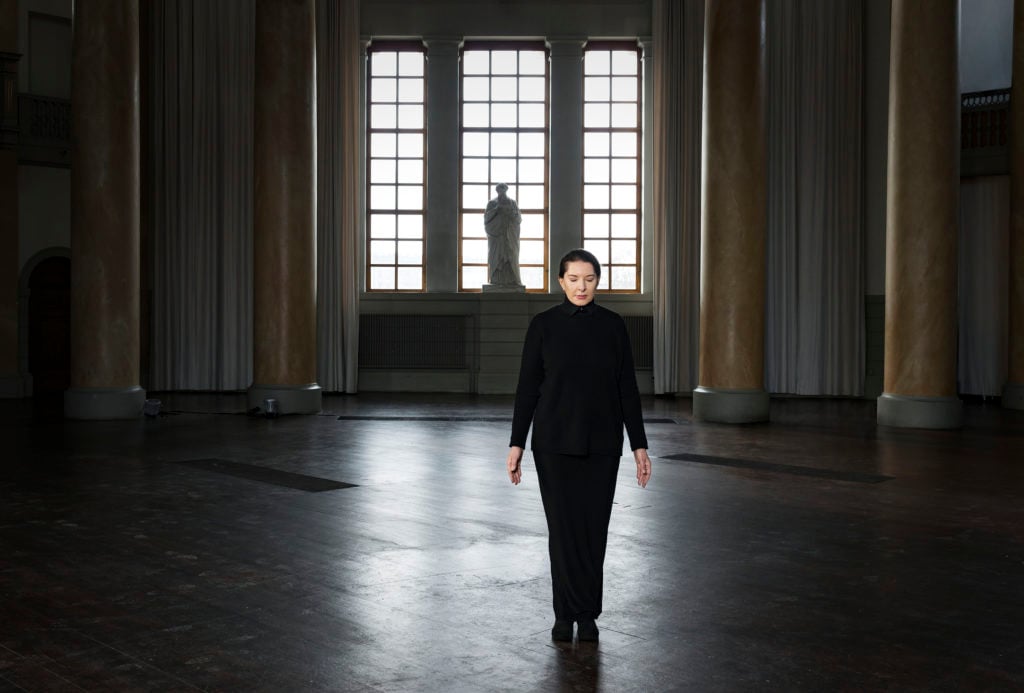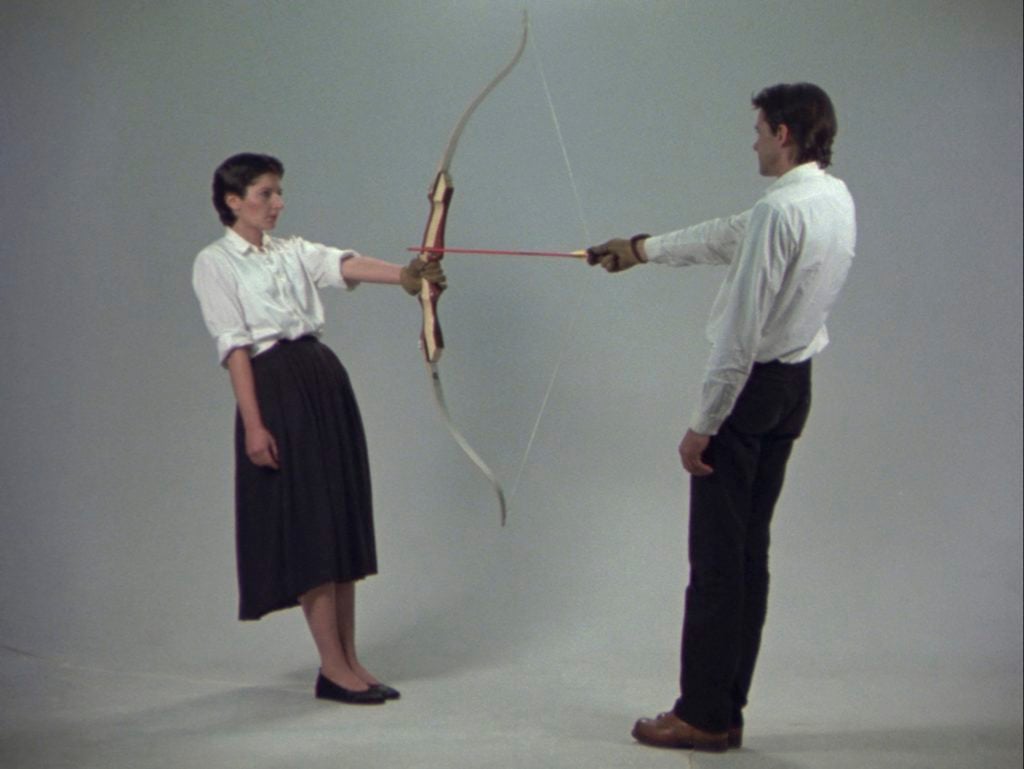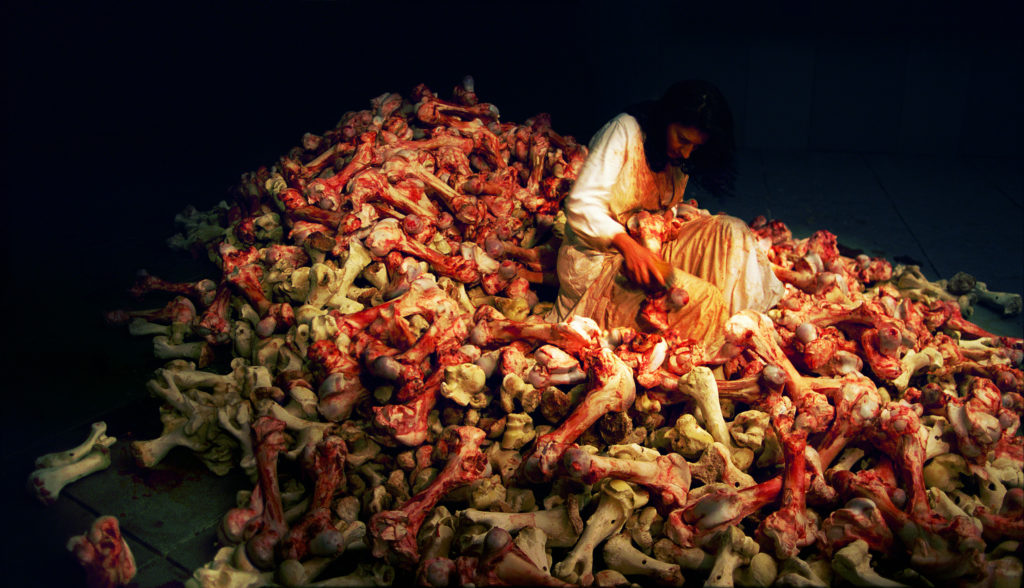Reviews
Marina Abramović’s First European Retrospective Reminds Us How She Reached Superstardom
Despite a few esoteric phases, the artist has stuck to her guns for half a decade.

Despite a few esoteric phases, the artist has stuck to her guns for half a decade.

Alyssa Buffenstein

At 70 years old, Marina Abramović owes her celebrity status only in part to her prolific career. Between 50 years exploring the limits of the body and power of the mind through performance art, her major MoMA retrospective and documentary, “The Artist Is Present” (2010 and 2012), and friendships and collaborations with the likes of James Franco, Lady Gaga, and Jay Z—not to mention the slew of controversy that fame inevitably brings—it can be easy to subconsciously substitute “Marina Abramović, The Celebrity” for “Marina Abramović, The Artist.” But a new retrospective on The Artist at Stockholm’s Moderna Museet, the first of its kind in Europe, reminds us why, exactly, she is so acclaimed.
Her earliest work might come as a shock to those who only know her as a contemporary star. She studied art in her hometown of Belgrade, and then in Zagreb, in the late 1960s, making paintings and drawings before finding performance.
She came of age at a time of extremes in the genre. In 1964, Yoko Ono (b. 1933) performed Cut Piece, inviting viewers to cut off her clothing with a pair of scissors. In 1971, Chris Burden, (born 1946, the same year as Abramović; died in 2015) had himself shot for the sake of art. The next year, Vito Acconci (b. 1940) performed Seedbed, masturbating underneath a ramp inside New York’s Sonnabend Gallery, while gallerygoers walked on top to the soundtrack of him reciting sexual fantasies. In 1974, Burden had himself Crucified to a Volkswagen Beetle.

Marina Abramović, Rhythm 5 (1974) ©Marina Abramović/Bildupphovsrätt 2017. Photo ©Nebojsa Cankovic,
Courtesy of the Marina Abramović Archives.
Abramović’s contributions to this golden era of sadomasochistic, provocative performance are her earliest works out of art school. For a 1975 piece, Lips of Thomas, a table is set with a glass and bottle of red wine, a jar of honey and a spoon, a metronome, a razorblade, and a black leather whip. Nearby are four large blocks of ice arranged in the shape of a cross, with a heater hanging above. On the wall is an inverted five-pointed star (derived from Communism, not from Satanists), and above that, a naked Abramović is seen in a video projection, whipping herself, with a matching five-pointed star carved into her skin.
Thanks to a wall text, the viewer learns that in the original performance, Abramović imbibed the honey and wine, broke the glass, cut the star into her skin with the razorblade, whipped herself until she felt no pain, and positioned herself on the ice cross, the heater directed at her fresh wound. She laid there, freezing, burning, and bleeding, for thirty minutes. According to the wall text, written by Abramović, when viewers removed her “the audience interrupts the piece.”
By this point, Abramović knew how to test her audience as well as herself. One year prior, she performed Rhythm 5, passing out—unplanned—inside a five-pointed star of fire. Two audience members rescued her when she nearly caught fire, yet her documentation of the piece also reads, “The piece was interrupted.”
Save death, where could she go from there?
In 1975, she met Ulay. The two merged their lives and art practices. At the museum, the documentation of their collaboration—which famously ended in 1988 with The Lovers, their Great Wall of China breakup piece—comes in the form of video projections of their symbiotic performances. They are kissing, slapping each other; he is shooting her with an arrow; they are standing together, naked, in a doorway while viewers pass between. Surrounded by these moving images is the van in which they lived for ten years.

Ulay/Marina Abramović, Rest Energy (1980) ©Ulay/Marina Abramović/Bildupphovsrätt 2017. Courtesy of the Marina Abramović Archives.
Post-breakup, as this narrative tells it, Abramović hit a Balkan phase, after having studied meditation getting into everything from hypnosis to alchemy with everyone from Tibetan Monks, Sufis, and Australian Aborigines. In the 1990s, in light of the Balkan wars and newfound singleness, Abramović looked to her ancestry, ready to examine the self that she had purged in 1975 with the Freeing series.
She scrubs blood from animal bones and dances with a red scarf in Balkan Baroque, which won her the Golden Lion at the 1997 Venice Biennale. For Balkan Erotic Epic (2005), she researched the region’s folk culture and created a video work with a row of performers massaging their naked breasts in an open field. In Count on Us (2004), a children’s choir sings the hymn of the United Nations, and then surrounds Abramović in a five-pointed star.

Marina Abramović, Balkan Baroque (1997) ©Marina Abramović/Bildupphovsrätt 2017. Courtesy of the Marina Abramović Archives.
Moving quickly past a crystal energy phase, all of a sudden it is 2010, and The Artist is Present. The MoMA performance is so ubiquitous it is hard to spend any time at all with it at the Moderna Museet—especially since space is relatively confined, the sounds of moaning, singing, and whipping from other rooms can be heard over the partitioned walls, and now, the artist is actually not present.
Perhaps Abramo-mania has not taken over Stockholm in the capacity it has elsewhere, in which case the retrospective catches Swedish viewers up to speed. A retrospective setting makes it impossible to engage with the works as originally intended, so luckily, those viewers (who, apparently, made a line around the block on opening night) also have the chance to participate in two new works. One, Counting the Rice, is a long wooden table situated in the museum’s lobby, inviting viewers to wear noise cancelling headphones and “separate and count” grains of rice in a central trough.
The other is a new performance, a collaboration between the museum and the Eric Ericson International Choral Centre. Abramović aims to “create a shared experience” between herself, a constantly-singing choir, and visitors, who are asked to check watches, cell phones, and coats at the door.
Inexplicably titled The Cleaner, the mature work is a fitting title for a retrospective of Abramović’s 50-year career. From audience participation, being in the (durational) moment, an air of mystery (and myticism), and even the use of a choir; it is clear that, while Abramović’s approach—and celebrity status—have changed over the past half-decade, she has remained true to the most central of her artistic interests through it all.
Marina Abramovic, “The Cleaner” is on view at the Moderna Museet in Stockholm until May 21, 2017.